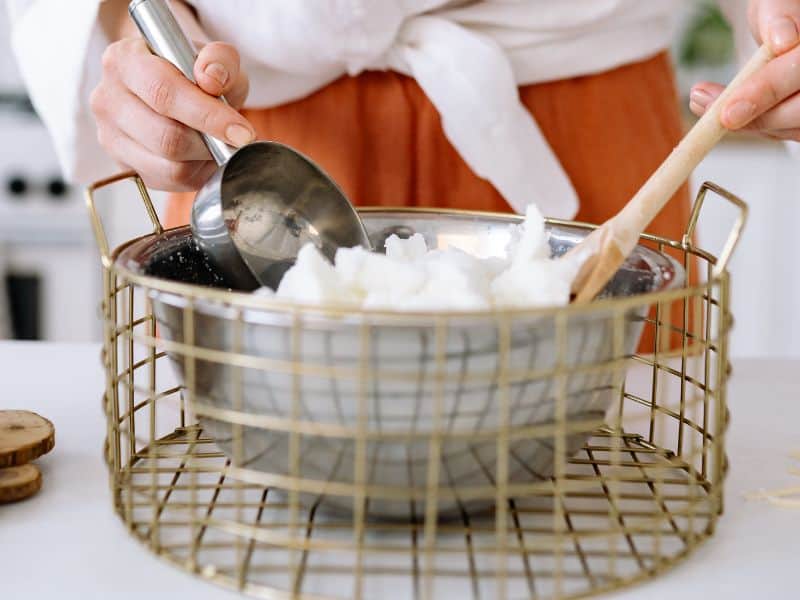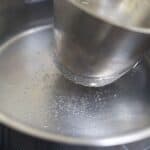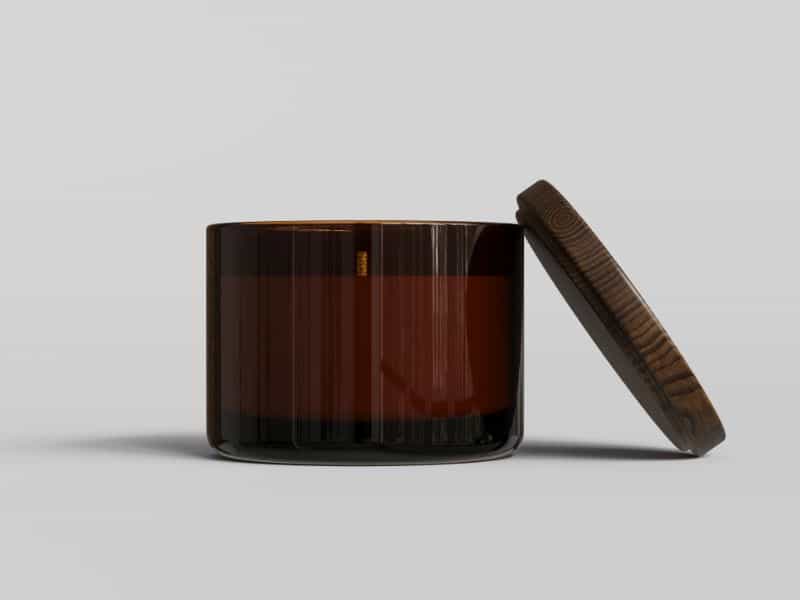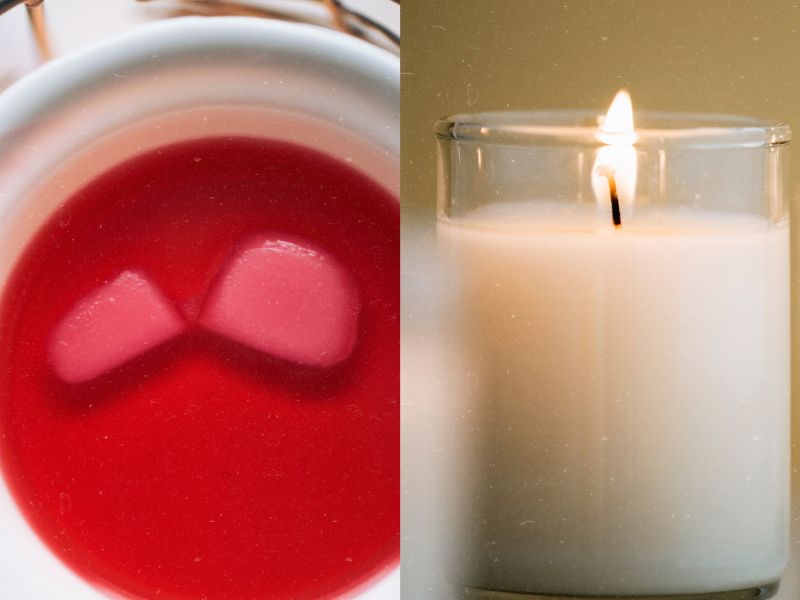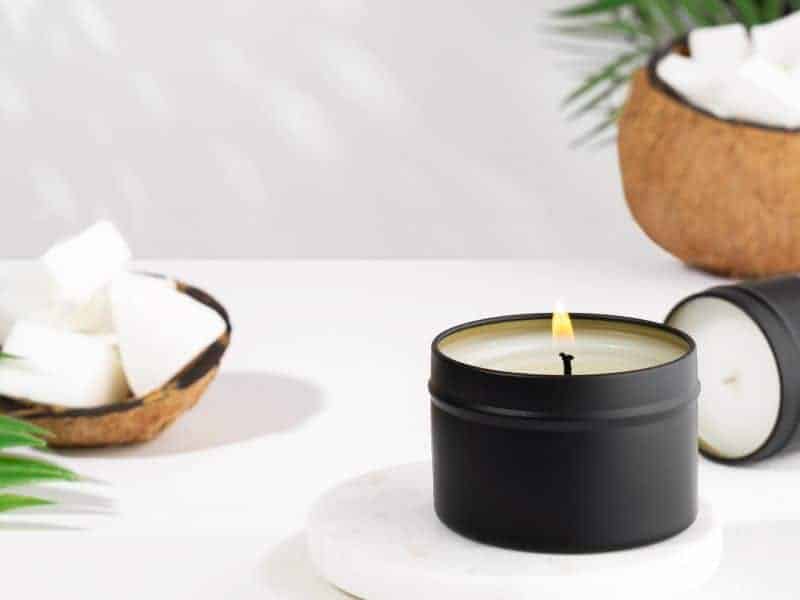Two widely-used waxes are paraffin and soy wax. Paraffin has been a staple in candle making for many years. Soy wax, on the other hand, is a newer popular option on the scene. We will explore whether mixing these two waxes is possible and the advantages of doing so.
You can mix soy wax and paraffin wax, it creates a blend with enhanced properties. Mixing soy and paraffin creates a blend that carries the benefits of both waxes. This allows for a cost-effective solution that balances sustainability, scent throw, and color retention in your candles.
The benefits of adding soy wax to a product made with paraffin include an increase in scent throw, improved color retention, and better glass adhesion. Mixing soy wax with paraffin also helps to create a more sustainable product, as soy wax is biodegradable and made from renewable resources.
Paraffin Wax
Paraffin wax is a white, odorless, and tasteless material obtained from the refining of petroleum. It is a popular choice in candle making because of its affordability, wide availability, and excellent burning characteristics.
Pros and cons
Pros:
- Cost-effective and widely available
- Burns with a bright and steady flame
- Holds fragrance and color effectively
- Offers a wide range of melting points for various candle types
Cons:
- Derived from non-renewable fossil fuels
- Can produce soot and release potentially harmful chemicals when burned
- Less environmentally friendly compared to plant-based waxes
- Lower-quality paraffin candles may produce more smoke and residue
Popular uses
Paraffin wax is versatile and suitable for a variety of candle styles, including:
- Pillar candles, known for their sturdy structure and long burn time
- Container candles, such as jar or tin candles, which are popular for their ease of use and portability
- Votive candles, often used for decoration or in religious ceremonies
- Taper candles, which are tall, thin, and elegant, typically used for dining table centerpieces or in candelabras
Soy Wax
Soy wax, derived from the hydrogenation of soybean oil, is a natural, renewable, and biodegradable wax. It has gained significant popularity among candle makers and enthusiasts due to its eco-friendly properties, smooth finish, and creamy appearance.
Pros and cons
Pros:
- Environmentally friendly, sustainable, and derived from a renewable source
- Provides a longer burn time compared to paraffin wax
- Generates less soot, resulting in a cleaner burn and reduced indoor pollution
- Spills are easy to clean with warm water and soap
- Offers good scent retention for a natural wax
Cons:
- Generally more expensive than paraffin wax
- Can be sensitive to temperature fluctuations, affecting candle appearance
- May not hold color as vibrantly as paraffin wax
- Requires larger wicks for optimal burning
- Can develop frosting or wet spots due to its natural composition
Popular uses
Soy wax is versatile and suitable for various candle types, including:
- Container candles, as it adheres well to glass, ceramic, and metal surfaces
- Pillar candles, when combined with other waxes or additives to improve structural integrity
- Wax melts and tarts, providing a safe, eco-friendly, and easy-to-use alternative to traditional candles
A Comprehensive Guide to Mixing Paraffin and Soy Wax
Compatibility of Paraffin and Soy Wax
Paraffin and soy wax are compatible for blending, allowing candle makers to create candles that feature the best qualities of both waxes.
To achieve the perfect balance of characteristics, it is crucial to experiment with different ratios of these two waxes.
Advantages of Blending Paraffin and Soy Wax
There are several benefits to mixing paraffin and soy wax, including:
- Combining the bright flame and superior fragrance throw of paraffin wax with the environmentally friendly nature of soy wax
- Achieving a smoother, creamier appearance than when using either wax individually
- Enhancing color stability and retention in the finished candles
- Improving scent throw while still maintaining a cleaner burn than paraffin wax alone
- Providing a cost-effective solution by balancing the affordability of paraffin wax with the sustainability of soy wax
Steps to Blend Paraffin and Soy Wax Effectively
To successfully mix paraffin and soy wax, follow these steps:
- Determine the desired wax ratio (e.g., 70% paraffin, 30% soy or 50% paraffin, 50% soy)
- Melt each wax separately in a double boiler or a dedicated melting pot, ensuring they reach the recommended pouring temperature
- Combine the melted waxes, making sure they have similar temperatures to prevent separation
- Stir the mixture gently but thoroughly to ensure even blending
- Add colorants and fragrances as desired, adhering to the manufacturer’s guidelines for both waxes
- Pour the blended wax into molds or containers, then allow it to cool and harden, keeping an eye out for any shrinkage or imperfections
Tips for Successful Wax Blending
Importance of Temperature Control
During the melting and blending process, maintaining accurate temperature control is essential. Use a thermometer to monitor the temperature and ensure both waxes reach their recommended pouring temperatures.
Proper Stirring Techniques
To achieve a uniform mixture, stir the waxes gently but thoroughly. Over-stirring can introduce air bubbles, while under-stirring may result in separation. Use a silicone or stainless steel spatula to avoid scratching your melting pot.
Testing Small Batches
Before moving to large-scale production, create small test batches to determine the best wax ratios, fragrance load, and wick size. This trial-and-error approach will help you fine-tune your candle recipe for optimal results.
Most Popular Wax Blends
Paraffin-Soy Wax Blend
Characteristics and Benefits:
A paraffin-soy wax blend merges the bright flame, color retention, and strong scent throw of paraffin wax with the eco-friendliness and cleaner burn of soy wax.
Ideal Applications:
This blend is suitable for container candles, pillar candles, and wax melts, offering a balanced, cost-effective, and versatile option.
Beeswax-Coconut Wax Blend
Characteristics and Benefits:
A beeswax-coconut wax blend provides a slow, clean burn and a naturally sweet honey scent from beeswax, combined with the creamy texture and excellent scent throw of coconut wax.
Ideal Applications:
This blend is perfect for container candles, votive candles, and wax melts, offering an environmentally friendly and luxurious alternative to traditional waxes.
Palm Wax-Soy Wax Blend
Characteristics and Benefits:
A palm wax-soy wax blend fuses the unique crystalline appearance and hardness of palm wax with the sustainability and longer burn time of soy wax.
Ideal Applications:
This blend is ideal for pillar candles, votive candles, and container candles, offering a visually appealing and eco-conscious choice.
Rapeseed Wax-Beeswax Blend
Characteristics and Benefits:
A rapeseed wax-beeswax blend combines the natural, honey-like scent and burn quality of beeswax with the sustainability and affordability of rapeseed wax.
Ideal Applications:
This blend is suitable for container candles, pillar candles, and wax melts, providing a renewable and biodegradable option.
Customizing Your Own Wax Blend
Factors to Consider:
When creating your custom blend, consider factors such as melting point, fragrance load, hardness, and burn quality.
Experiment with different wax ratios to achieve the desired properties and performance.
Tips for Successful Blending:
Ensure accurate temperature control, use proper stirring techniques, and test small batches before scaling up. Adapt and refine your recipe based on the results of your experiments, and be prepared to make adjustments as needed to achieve your desired outcome.
Experimenting with Wax Blends
Creative benefits
Experimenting with wax blends unlocks a world of creativity in candle making. By combining different waxes, you can achieve unique characteristics, such as burn time, scent throw, and visual appeal.
The possibilities are nearly endless, allowing you to develop candles that suit your personal preferences or cater to a specific market.
Unique scents and textures
Blending waxes can help you create one-of-a-kind scents and textures in your candles. By combining different fragrance oils and essential oils, you can develop custom scents that set your candles apart.
Additionally, blending waxes can produce visually stunning effects, such as marbling, layered colors, or a combination of textures.
Customized candle making
By experimenting with wax blends, you can tailor your candles to meet specific needs, such as eco-friendliness, burn quality, or cost-effectiveness.
This customization allows you to create candles that align with your values and preferences, making your candle-making journey even more rewarding.
Conclusion
In conclusion, mixing paraffin and soy wax is not only possible but can result in candles with improved properties. Blending these waxes allows you to harness the best qualities of both, including the bright flame, fragrance throw, and color retention of paraffin, along with the eco-friendliness and cleaner burn of soy wax.
As a candle maker, it’s essential to embrace experimentation and explore the limitless possibilities of wax blending. By testing different wax ratios, fragrance loads, and wick sizes, you can create unique candles that showcase your creativity and passion for the craft.

